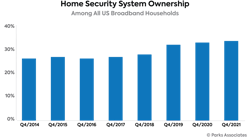This article originally appeared in the September 2022 issue of Security Business magazine. When sharing, don’t forget to mention Security Business magazine on LinkedIn and @SecBusinessMag on Twitter.
Security system adoption has steadily increased in recent years, having now reached 36% of U.S. internet households. Adoption is driven by recent advances in DIY installation, reduction of service and hardware costs, and a growing need for peace of mind.
Residential security customers in single-family and SMB properties have a myriad of installation methods, alert methods, device types, and associated services available. Most consumers can find a system that provides the peace of mind they are seeking; however, many traditional security solutions have gaps in their coverage where there is too much time between detecting the break-in, sounding the alarm, and the arrival of the police to prevent property damage or loss.
In the future, the most successful residential security providers will incorporate the innovations that overcome the limitations of the previous generation of security systems and most effectively lean into these peace-of-mind demands from consumers.
Evolving Tech Leads to Rise in Demand
Security system ownership is at an all-time high in multiple sectors, thanks to advances in video verification technology, new AI and machine learning technology, smart features that deter bad actors or stop them in their actions, and industry partnerships that continue to enable new applications and services.
Professional monitoring centers are leveraging this technology to reduce response time and false alarms for the system owners – driving further adoption of these systems while also reducing the central station’s labor costs.
In the residential sector, more than half of each of the following key demographics own a security system:
- Households with children
- Households with an income of $100,000 or more
- Heads of household ages 35-44
- Residents in an urban areas
MDUs and SMBs Contribute to Deployment Increases
Security system use is particularly common in multi-dwelling properties. Parks Associates research shows that 41% of multi-dwelling unit (MDU) property managers have a security/access system for common property areas and parking garages. Additionally, 36% of properties with a common-area security system incorporate internet-connected devices into the system for remote monitoring and control.
Smart camera monitoring and smart parking rentals are the most common safety and security use-cases among property managers that currently use smart home devices. SMBs with more employees, more revenue, and working in locations out of the home are also more likely to use security systems. Warehouse and retail locations have particularly high-security system presence.
The past several years have been a net driver for security solutions among SMBs. Along with the pandemic itself, the spring and summer of 2020 were characterized by social and political unrest, resulting in heightened concerns about safety and security. In 2020, one in five SMBs reported that the COVID-19 crisis had increased their need for products and services to protect or monitor the safety and security of their business locations and employees.
Regardless of system type and monitoring status, security system customers demand optimal response times between security events and first responders' arrival. With new innovations, built-in security features can interrupt and deter crime in real-time, bringing required response times down to zero.




